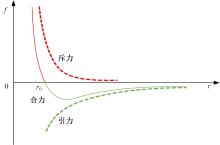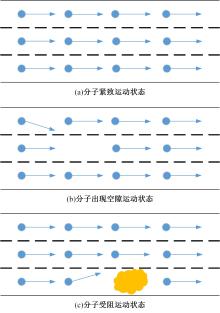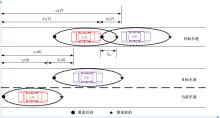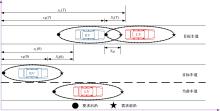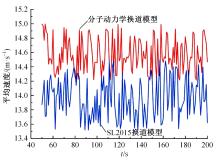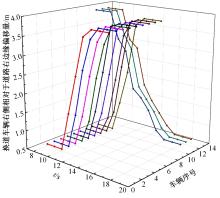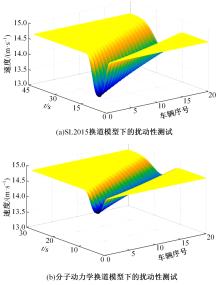Journal of Jilin University(Engineering and Technology Edition) ›› 2024, Vol. 54 ›› Issue (3): 700-710.doi: 10.13229/j.cnki.jdxbgxb.20220465
Analysis of lane⁃changing decision⁃making behavior and molecular dynamics modeling for autonomous vehicles
Da-yi QU1( ),Ke-kun ZHANG1,Yuan GU2,Tao WANG1,3,Hui SONG1,Shou-chen DAI1
),Ke-kun ZHANG1,Yuan GU2,Tao WANG1,3,Hui SONG1,Shou-chen DAI1
- 1.School of Mechanical and Automotive Engineering,Qingdao University of Technology,Qingdao 266520,China
2.Marketing Center,China FAW Group Co. ,Ltd. ,Changchun 130012,China
3.School of Artificial Intelligence and Big Data,Zibo Vocational and Technical College,Zibo 255300,China
CLC Number:
- U491.2
| 1 | Gipps P G. A model for the structure of lane changing decisions[J]. Transportation Research Part B: Methodological, 1986, 20(5): 403-414. |
| 2 | Jula H, Kosmatopoulos E B, Ioannou P A. Collision avoidance analysis for lane changing and merging[J]. IEEE Transactions on Vehicular Technology, 2000, 49(6): 2295-2308. |
| 3 | Kanaris A, Kosmatopoulos E B, Loannou P A. Strategies and spacing requirements for lane changing and merging in automated highway systems[J]. IEEE Transactions on Vehicular Technology, 2001, 50(6): 1568-1581. |
| 4 | 郭海兵, 曲大义, 洪家乐, 等. 基于效用理论的车辆换道交互行为及决策模型[J]. 科学技术与工程, 2020, 20(29): 12185-12190. |
| Guo Hai-bing, Qu Da-yi, Hong Jia-le, et al. Vehicle lane changing interaction behavior and decision model based on utility theory[J]. Science Technology and Engineering, 2020, 20(29): 12185-12190. | |
| 5 | 李传友. 高速公路环境下智能车辆自动换道研究[D]. 西安: 长安大学汽车学院, 2019. |
| Li Chuan-you. Research on intelligent vehicle automatic lane change in expressway environment[D]. Xi'an: College of Automobile, Chang'an University, 2019. | |
| 6 | 曲大义, 黑凯先, 郭海兵, 等. 车联网环境下车辆换道博弈行为及模型[J]. 吉林大学学报:工学版, 2022, 52(1): 101-109. |
| Qu Da-yi, Kai-xian Hei, Guo Hai-bing, et al. Game behavior and model of lane-changing on the Internet of vehicles environment[J]. Journal of Jilin University(Engineering and Technology Edition), 2022, 52(1): 101-109. | |
| 7 | Reuschel A. Vehicle movements in a platoon[J]. Oesterreichisches Ingenieeur-Atchir, 1950, 4(1): 193-215. |
| 8 | 杨晶茹. 车路协同环境下驾驶行为特性及其模型[D]. 青岛: 青岛理工大学机械与汽车工程学院, 2019. |
| Yang Jing-ru. Driving behavior characteristics and models under vehicle-infrastructure cooperation[D]. Qingdao: School of Mechanical and Automotive Engineering, Qingdao University of Technology, 2019. | |
| 9 | 黑凯先, 曲大义, 郭海兵, 等. 网联混合车流车辆换道博弈行为及模型[J]. 科学技术与工程, 2021, 21(6): 2495-2501. |
| Kai-xian Hei, Qu Da-yi, Guo Hai-bing, et al. Modeling lane-changing behavior in mixed traffic flow connected environment based on game behavior[J]. Science Technology and Engineering, 2021, 21(6): 2495-2501. | |
| 10 | 文成. 耦合博弈论—运动学的自动驾驶换道决策研究[D]. 成都: 西南交通大学交通运输与物流学院, 2019. |
| Wen Cheng. Coupled game theory-kinematics decision making for automatic driving lane change[D]. Chengdu: School of Transportation and Logistics of Southwest Jiaotong University, 2019. | |
| 11 | 杨龙海, 王晖, 李帅, 等. 改进分子动力学的车辆跟驰模型[J]. 重庆大学学报, 2021, 44(7): 26-33. |
| Yang Long-hai, Wang Hui, Li Shuai, et al. Car-following model with improved molecular dynamics[J]. Journal of Chongqing University, 2021, 44(7): 26-33. | |
| 12 | 黎宇科, 刘宇. 国内智能网联汽车发展现状及建议[J]. 汽车与配件, 2016, 2016(41): 56-59. |
| Li Yu-ke, Liu Yu. Development status and suggestions of domestic intelligent connected vehicles[J]. Automobile and Parts, 2016, 2016(41): 56-59. | |
| 13 | 孟鑫. 混合车流环境下城市快速路交织区仿真研究[D]. 长春: 吉林大学交通学院, 2019. |
| Meng Xin. Research on the simulation of the weaving area on the urban expressway under the mixed traffic environment[D]. Changchun: College of Transportation, Jilin University, 2019. | |
| 14 | 时柏营, 杨晓光, 于晓斐. 考虑与跟驰模型结合的自由换道模型及仿真[J]. 交通科学与工程, 2009, 25(4): 91-96. |
| Shi Bai-ying, Yang Xiao-guang, Yu Xiao-fei. Modeling and simulation of discretionary lane-change considering the combination with the car-following model[J]. Journal of Transport Science and Engineering, 2009, 25(4): 91-96. | |
| 15 | 曲大义, 邴其春, 贾彦峰, 等. 基于分子动力学的车辆换道交互行为特性及其模型[J]. 交通运输系统工程与信息, 2019, 19(3): 68-74. |
| Qu Da-yi, Bing Qi-chun, Jia Yan-feng, et al. Molecular dynamics characteristics and models of vehicle lane changing interaction behavior[J]. Journal of Transportation Systems Engineering and Information Technology, 2019, 19(3): 68-74. | |
| 16 | 李娟, 曲大义, 刘聪, 等. 基于分子动力学的跟驰特性及其模型[J]. 公路交通科技, 2018, 35 (03): 126-131. |
| Li Juan, Qu Da-yi, Liu Cong, et al. Car-following characteristics and its models based on molecular dynamics[J]. Journal of Highway and Transportation Research and Development, 2018, 35(3): 126-131. | |
| 17 | 曲大义, 赵梓旭, 贾彦峰, 等. 基于Lennard-Jones势的车辆跟驰动力学特性及模型[J]. 吉林大学学报:工学版, 2022, 52(11): 2549-2557. |
| Qu Da-yi, Zhao Zi-xu, Jia Yan-feng, et al. Car-following dynamics characteristics and model based on Lennard-Jones potential[J]. Journal of Jilin University(Engineering and Technology Edition), 2022, 52(11): 2549-2557. | |
| 18 | 李娟. 基于分子动力学的车流运行特性及其模型研究[D]. 青岛: 青岛理工大学汽车与交通学院, 2018. |
| Li Juan. Study on traffic flow characteristics and its model based on molecular dynamics[D]. Qingdao: School of Automobile and Transportation, Qingdao University of Technology, 2018. | |
| 19 | Erdmann Jakob. Modeling Mobility with Open Data[M]. USA: Springer International Publishing, 2015: 105-123. |
| 20 | 包智鹏, 支永帅, 张素民, 等. 基于BiGRU的多模态驾驶行为及轨迹预测[J]. 大连理工大学学报, 2021, 61(3): 246-254. |
| Bao Zhi-peng, Zhi Yong-shuai, Zhang Su-min, et al. BIGRU based multi-modal maneuvers and trajectory prediction[J]. Journal of Dalian University of Technology, 2021, 61(3): 246-254. | |
| 21 | 曲大义, 杨建, 陈秀锋, 等. 车辆跟驰的分子动力学特性及其模型[J]. 吉林大学学报:工学版, 2012, 42(5): 1198-1202. |
| Qu Da-yi, Yang Jian, Chen Xiu-feng, et al. Molecular kinetics behavior of car-following and its model[J]. Journal of Jilin University(Engineering and Technology Edition), 2012, 42(5): 1198-1202. |
| [1] | Sheng-qian ZHAO,Zhuo-hong CONG,Qing-long YOU,Yuan LI. Adhesion and raveling property between asphalt and aggregate: a review [J]. Journal of Jilin University(Engineering and Technology Edition), 2023, 53(9): 2437-2464. |
| [2] | Zhi ZHENG,Pei YUAN,Xuan-hui JIN,Si-si WEI,Bo GENG. Experimental on composite flexible anti⁃collision fender of bridge pier [J]. Journal of Jilin University(Engineering and Technology Edition), 2023, 53(9): 2581-2590. |
| [3] | Yong-ming HE,Shi-sheng CHEN,Jia FENG,Ya-nan WAN. Superhighway virtual track system based on high precision map [J]. Journal of Jilin University(Engineering and Technology Edition), 2023, 53(7): 2016-2028. |
| [4] | Guo-zhu CHENG,Lin SHENG,Hao ZHAO,Tian-jun FENG. Exclusive phase setting condition of signalized intersection based on risk analysis [J]. Journal of Jilin University(Engineering and Technology Edition), 2023, 53(7): 1962-1969. |
| [5] | Zhi-jia XUE,Zhao-yang WANG,Jiu-peng ZHANG,Chang-gen YAN,Zi-kai XU,Ying-li ZHANG,Xiao-ming Huang,Tao Ma. Toughness analysis and improvement of road structure under action of debris flow [J]. Journal of Jilin University(Engineering and Technology Edition), 2023, 53(6): 1773-1781. |
| [6] | Xue XIAO,Ke-ping LI,Bo PENG,Man-wei CHANG. Integrated lane⁃changing model of decision making and motion planning for autonomous vehicles [J]. Journal of Jilin University(Engineering and Technology Edition), 2023, 53(3): 746-757. |
| [7] | Rong-han YAO,Wen-tao XU,Wei-wei GUO. Drivers' takeover behavior and intention recognition based on factor and long short⁃term memory [J]. Journal of Jilin University(Engineering and Technology Edition), 2023, 53(3): 758-771. |
| [8] | Min MA,Da-wei HU,Lan SHU,Zhuang-lin MA. Resilience assessment and recovery strategy on urban rail transit network [J]. Journal of Jilin University(Engineering and Technology Edition), 2023, 53(2): 396-404. |
| [9] | Jing WANG,Feng WAN,Chun-jiao DONG,Chun-fu SHAO. Modelling on catchment area and attraction intensity of urban rail transit stations [J]. Journal of Jilin University(Engineering and Technology Edition), 2023, 53(2): 439-447. |
| [10] | Zhi-wei LIU,Zheng-yun SONG,Jian-rong LIU. Impact of shared autonomous vehicles on choice of subway station connection methods [J]. Journal of Jilin University(Engineering and Technology Edition), 2023, 53(12): 3424-3431. |
| [11] | Zhi-fa YANG,Bo SUN,Xian-jun FAN,Wen-cai SUN,Jing-jing TIAN,Ning SUN. Simulation on energy consumption of truck fleet on expressway under background of vehicle⁃infrastructure cooperative environment [J]. Journal of Jilin University(Engineering and Technology Edition), 2023, 53(12): 3452-3457. |
| [12] | Jian-cheng WENG,Rui-cong WEI,Han-mei HE,Hai-hui XU,Jing-jing WANG. Urban road network short-term traffic flow prediction model based on associated road chain group [J]. Journal of Jilin University(Engineering and Technology Edition), 2023, 53(11): 3104-3112. |
| [13] | Song FANG,Jian-xiao MA,Gen LI,Ling-hong SHEN,Chu-bo XU. Traffic risk analysis of moving work zone on right lane of city expressway [J]. Journal of Jilin University(Engineering and Technology Edition), 2022, 52(8): 1786-1791. |
| [14] | Hong-feng XU,Hong-jin CHEN,Dong ZHANG,Qian-hui LU,Na AN,Xian-cai Geng. Fully⁃actuated signal timing technique for isolated signalized intersections in connected vehicle environment [J]. Journal of Jilin University(Engineering and Technology Edition), 2022, 52(6): 1324-1336. |
| [15] | Song-xue GAI,Xiao-qing ZENG,Xiao-yuan YUE,Zi-hao YUAN. Parking guidance model based on user and system bi⁃level optimization algorithm [J]. Journal of Jilin University(Engineering and Technology Edition), 2022, 52(6): 1344-1352. |
|
||


